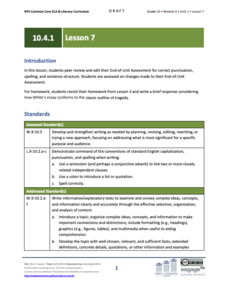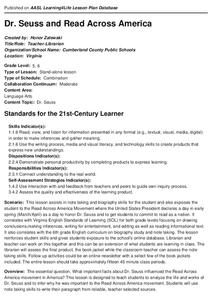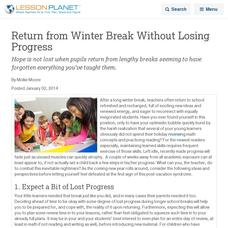EngageNY
Grade 10 ELA Module 3: Unit 3, Lesson 10
Can budding writers accept constructive criticism? Learners work with their peers to gain feedback about their argumentative essay drafts. Peers give one another constructive criticism to revise their work better. Using a Peer Review...
EngageNY
Grade 10 ELA Module 4: Unit 1, Lesson 7
High school writers participate in peer review of their end-of-unit tasks. They begin by discussing their thought process in pairs and then editing their work. Finally, learners participate in a class discussion on the use of the...
British Council
Unit 8: Proofreading
Plagued by punctuation or stymied by spelling? Lesson eight in a nine-part series of career education and skills activities introduces the importance of proofreading. Learners categorize common writing errors and construct error-free...
University of North Carolina
Editing and Proofreading
Writing is not a one and done process. In fact, the stages of editing and proofreading, the focus of a flyer from a larger set of writing skills handouts, play a major role in creating a strong paper. However, as the reference sheet...
American Press Institute
In the Newsroom: The Fairness Formula
Reporting the news is easy, right? Think again! Show young scholars the difficult choices journalists make every day through a lesson that includes reading, writing, and discussion elements. Individuals compare the language and sources...
EngageNY
Grade 9 ELA Module 4, Unit 1, Lesson 29
Writers review the provided essay rubric, edit and rewrite if necessary, polish their work, and then submit their argument essay.
EngageNY
Grade 9 ELA Module 4, Unit 1, Lesson 28
As writers continue to revise their argument essays, the focus shifts to editing grammatical conventions, parallel structure, and varying syntax to add interest. After examining model sentences that demonstrate sentence variety, writers...
EngageNY
Grade 9 ELA Module 4, Unit 1, Lesson 27
Crafting a clear and cohesive conclusion to any piece of writing is crucial. An effective conclusion restates the central claim in the introduction, briefly summarizes the supporting claims, and presents a new way of thinking about the...
EngageNY
Grade 9 ELA Module 3, Unit 3, Lesson 8
Writers complete editing and polishing the final draft of their research paper and submit the document for assessment.
EngageNY
Grade 9 ELA Module 3, Unit 3, Lesson 7
As the unit on research writing draws to a close, class members continue to revise and edit their papers, this time focusing on grammar, spelling, and punctuation (colon and semicolon).
Teach-nology
Editing Informal Letters
Editing a letter isn't quite the same thing as fixing an autocorrected word on your phone, but it's an important skill that can help kids with their language arts skills. Young readers take a look at a short letter before identifying the...
Curated OER
Dr. Seuss and Read Across America
What important facts about Dr. Seuss influenced the Read Across America movement...? This is the driving question of a research project that requires scholars to find information about Dr. Seuss' life and work. Class...
Mama's Learning Corner
Is This Sentence Correct? (capitalization and punctuation)
Turn your youngsters into little editors with an exercise that focuses on some of the most basic and important writing conventions: capitalization and punctuation. Learners fix five sentences and then rewrite a sentence using...
Vista Murrieta High School
English II Research Paper Packet
If your school requires a senior research paper or if you are considering one for your class, then this resource is for you. The 43-page packet includes everything from a sample letter to parents to requirements, from topic suggestions...
Pearson
Contractions, Plural Names, and Possessives: An Editing Exercise
Practice proper apostrophe use with a grammar learning exercise. After reviewing contractions, plural names, and possessive nouns, kids fix and rewrite 10 incorrect sentences.
Curated OER
Revising vs. Editing
Are your young writers unsure of what to look for when asked to edit a draft of writing? Direct them to this simple and attractive printable, which uses two acronyms—ARMS (add, remove, move, substitute) and CUPS capitalize, usage,...
Curated OER
The Writing Process
From planning and drafting to revising and publishing, consistently remind your young writers of the major steps of the writing process with this attractive printable!
Curated OER
Return from Winter Break Without Losing Progress
Hope is not lost when pupils return from lengthy breaks seeming to have forgotten everything you’ve taught them.
EngageNY
Editing and Publishing: Accessing Books Around the World Informative Paragraph
Provide time to polish paragraphs in class. Pupils, who have been working on these informational pieces for several days now, will have a chance to check for spelling and grammar before publishing their work. Sure to be a rewarding final...
Curated OER
Misplaced Modifiers
Misplaced modifiers can alter the meaning of a sentence, and take away from a writer's intended message. Use the reference sheet and activity to show middle schoolers how to edit confusing sentences with misplaced modifiers. A great...
Curated OER
Connectives
Using connectives and conjunctions is an easy way to vary sentence structure. Third graders review the given connectives, then use them to combine two simple sentences. The second section allows learners to use more words and phrases as...
Dorling Kindersley
Punctuation Practice
Need some punctuation practice? Challenge your third or fourth graders' editing skills with a helpful instructional activity on punctuation. After naming different types of punctuation marks, they rewrite a paragraph that has multiple...
Curated OER
Silly Spoonerisms!
Looking for a fun activity for your vocabulary lesson? Bring a activity on "spoonerisms" to your fifth grade class. Kids decipher seven phrases that have mixed up the first letter sounds of each word. They then think of their own...
Curated OER
Question Marks
Context clues are important when understanding the intent of a sentence. Kindergartners read eight sentences, and decide if each should end in a period or in a question mark. The last two questions prompt kids to draw a mouse and a cat,...

























